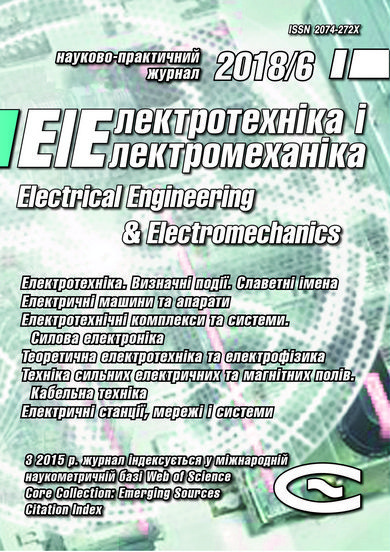OPTIMAL CONTROL OF THE ELECTRIC SHIPS’ PROPULSION MOTORS DURING REVERSAL
DOI:
https://doi.org/10.20998/2074-272X.2018.6.05Keywords:
control of propulsion motors during electric ships’ maneuvers, optimization method, optimal control lawsAbstract
Introduction. Reliability and safety of electric ships’ maneuverability depends on the maneuvering characteristics of their propulsion motors (PM). Therefore, the issues of improving the process of controlling propulsion motors at maneuvers are topical. The aim of this paper is to find the optimal laws of control. The indicators estimating electric ships’ maneuvering properties are chosen as criteria of optimality. Methodology. A proportional control law is traditionally used in electrical propelling plants with frequency-controlled PM. However, it does not provide the necessary maneuvering characteristics to the electric ships, since it does not take into account the process of the vessel's movement. To search for the optimal control laws of propulsion motors at maneuvers, the electrical propulsion plant is considered in unity with all the components of the ship’s propulsion complex. The dimensionless parameters of the complex are revealed from the mathematical model of the transient modes of its operation. They determine the numerical values of the optimality criteria. Control signals are formed by frequency and voltage. A method for the formation of optimal control laws is proposed. The nature of the target functions is revealed and a special optimization method is developed. A minimum of the braking distance and a minimum of energy spent on maneuvering are taken as criteria of optimality. Results. The parameters of the complexes that significantly affect the optimality criteria are revealed. For various combinations of the values of these parameters, optimization calculations have been carried out and the optimal control laws of the propulsion motors during electric ships’ reversal have been found. Optimization is carried out by the criterion of the minimum of the braking distance and by the criterion of minimum energy consumption. The results are presented in an analytical form and in a graphical form. The effectiveness of the proposed control laws is illustrated. Scientific novelty. The method of searching for the optimal control laws of the propulsion motors is constructed according to the system principle. This allows us to find the control laws of the propulsion motors on the final result – on the indicators of electric ships’ maneuverability. The proposed recommendations cover a wide class of vessels with electric motion. Practical value. The proposed optimal control laws for propulsion motors can be used both in the design of propulsion power plants and in their operation. The best control law can be selected and incorporated into the control system for any particular electric ship of the considered class, depending on the quality of maneuvering. In particular, the optimal control law for propulsion motors during reversal providing electric ship’s minimum braking distance or minimum energy consumption for maneuvering can be chosen.References
1. Yarovenko V.A. Raschet i optimizatsiia perekhodnykh rezhimov propul'sivnykh kompleksov elektrokhodov [Calculation and optimization of transient regimes of propulsion complexes of electric vessels].Odessa, Mayak Publ., 1999. 188 p. (Rus).
2. Yarovenko V.A., Chernikov P.S. A calculation method of transient modes of electric ships’ propelling electric plants. Electrical engineering & electromechanics, 2017, no.6, pp. 32-41. doi: 10.20998/2074-272X.2017.6.05. (Rus).
3. Sukharev A.G., Timokhov A.V., Fedorov V.V. Kurs metodov optimizatsii [Course of optimization methods].Moscow, Fizmatlit Publ., 2005. 368 p. (Rus).
4. Bonnans J.-F., Gilbert J.C., Lemarechal C., Sagastizábal C.A. Numerical optimization: theoretical and practical aspects. Berlin, Heidelberg: Springer-Verlag, 2006. 494 p. doi: 10.1007/978-3-662-05078-1.
5. Fletcher R. Practical Methods of Optimization. Wiley, 2000. 450 p. doi: 10.1002/9781118723203.
6. Antoniou A., Lu W.-S. Practical optimization. Algorithms and engineering applications. Springer, 2007. 675 p.
7. Floudas C.A., Pardalos P.M. Encyclopedia of optimization.Springer, 2009. 4646 p. doi: 10.1007/978-0-387-74759-0.
8. Panteleev A.V., Letova T.A. Metody optimizatsii v primerakh i zadachakh [Optimization methods in examples and problems].Moscow, High school Publ., 2008. 544 p. (Rus).
9. Chernikov P.S., Yarovenko V.A., Zaritskaya E.I. Influence of electric ships’ parameters on quality indices of electric power plants’ performance at maneuvers. Bulletin of the National Technical University «KhPI» Series: «Electric machines and electromechanical energy conversion», 2018, no.5(1281), pp. 46-54. (Rus).
Downloads
Published
How to Cite
Issue
Section
License
Copyright (c) 2018 V. A. Yarovenko, P. S. Chernikov, R. A. Varbanets, E. I. Zaritskaya

This work is licensed under a Creative Commons Attribution-NonCommercial 4.0 International License.
Authors who publish with this journal agree to the following terms:
1. Authors retain copyright and grant the journal right of first publication with the work simultaneously licensed under a Creative Commons Attribution License that allows others to share the work with an acknowledgement of the work's authorship and initial publication in this journal.
2. Authors are able to enter into separate, additional contractual arrangements for the non-exclusive distribution of the journal's published version of the work (e.g., post it to an institutional repository or publish it in a book), with an acknowledgement of its initial publication in this journal.
3. Authors are permitted and encouraged to post their work online (e.g., in institutional repositories or on their website) prior to and during the submission process, as it can lead to productive exchanges, as well as earlier and greater citation of published work.





